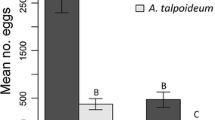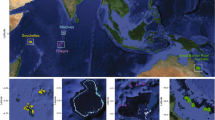Abstract
Mimicry is a vivid example of how predator-driven selection can impact phenotypic diversity, which itself can be influenced by the presence (sympatry) or absence (allopatry) of a dangerous model. However, the impact of sympatry and allopatry on predation on mimicry systems at fine spatial scales (e.g., edge sympatry, allopatry) is not well understood. We studied mimicry in a montane tropical site in Honduras with an abrupt elevational gradient where coral snakes and mimics exist in close sympatry and allopatry. Specifically, we used clay replicas to test the impact of edge sympatry on (1) overall attack rates, (2) the fitness benefit of mimetic coloration, and (3) predation on specific mimetic signal components. Unlike previous research, we found that mimetic phenotypes received significantly more attacks than cryptic replicas in edge sympatry, suggesting that mimetic phenotypes might not confer a fitness benefit in areas of edge sympatry. Additionally, we documented temporal variation in predator-based selection, as the impacts of allopatry on predatory attacks varied among years. Our results imply that the effect of sympatry and allopatry on predator-based selection in mimicry systems may be more complex than previously thought for species-rich assemblies of coral snakes and their mimics in the montane tropics.




Similar content being viewed by others
Data availability
Data available through Dryad at: https://doi.org/10.5061/dryad.pnvx0k6kv
Code availability
Software application or custom code.
Change history
21 February 2022
A Correction to this paper has been published: https://doi.org/10.1007/s10682-022-10161-0
References
Akcali CK, Kikuchi DW, Pfennig DW (2018) Coevolutionary arms races in Batesian mimicry? A test of the chase-away hypothesis. Biol J Lin Soc 124:668–676
Akcali CK, Pfennig DW (2014) Rapid evolution of mimicry following local model extinction. Biol Lett 10:20140304
Akcali CK, Pfennig DW (2017) Geographic variation in mimetic precision among different species of coral snake mimics. J Evol Biol 30:1420–1428
Alliance AS (2019) Spike-thumb Frog, Plectrohyla dasypus. Amphibian Survival Alliance
Arbuckle K, Speed MP (2015) Antipredator defenses predict diversification rates. Proc Natl Acad Sci U S A 112:13597–13602
Bateman PW, Fleming PA, Wolfe AK (2017) A different kind of ecological modelling: the use of clay model organisms to explore predator-prey interactions in vertebrates. J Zool 301:251–262
Bates D, Maechler M, Bolker B, Walker S (2015) Fitting linear mixed-effects models using lme4. J Stat Softw 67:1–48
Brodie E III (1993) Differential avoidance of coral snake banded patterns by free-ranging avian predators in Costa Rica. Evolution 47:227–235
Brodie III E, Janzen FJ (1995) Experimental studies of coral snake mimicry: generalized avoidance of ringed snake patterns by free-ranging avian predators. Funct Ecol 9:186–190
Brown T, Arrivillaga C (2017) Herpetofauna of Cusuco National Park. Operation Wallacea, Honduras
Brown TW, Barazowski MB, Lonsdale G (2020) Defensive tail-curling and head-mimicking behavior in a variable coralsnake, Micrurus diastema (Squamata: Elapidae) in Cusuco National Park, Honduras. Int Reptile Conserv Found 27:231–232
Charlesworth D, Charlesworth B (1975) Theoretical genetics of batesian mimicry I. Single-Locus Models. J Theor Biol 55:283–303
Cox CL, Davis Rabosky AR (2013) Spatial and temporal drivers of phenotypic diversity in polymorphic snakes. Am Nat 182:E40-57
Davis Rabosky AR, Cox CL, Rabosky DL, Title PO, Holmes IA, Feldman A, McGuire JA (2016) Coral snakes predict the evolution of mimicry across New World snakes. Nat Commun 7:11484
Davis Rabosky AR, Larson JG, Danforth SM, Moore TY (2020) A quantitative analysis of micrurus coral snakes reveals unexpected variation in stereotyped anti-predator displays within a mimicry system. Integr Org Biol 2:1–13
Endler JA (1986) Natural selection in the wild. Princeton University Press, Princeton
Finkbeiner SD, Salazar PA, Nogales S, Rush CE, Briscoe AD, Hill RI, Kronforst MR, Willmott KR, Mullen SP (2018) Frequency dependence shapes the adaptive landscape of imperfect Batesian mimicry. Proc R Soc B Biol Sci 285:20172786
Greene HW, McDiarmid RW (1981) Coral snake mimicry: does it occur? Science 213:1207–1212
Ham AD, Ihalainen E, Lindström L, Mappes J (2006) Does colour matter? The importance of colour in avoidance learning, memorability and generalisation. Behav Ecol Sociobiol 60:482–491
Harper GR Jr, Pfennig DW (2008) Selection overrides gene flow to break down maladaptive mimicry. Nature 451:1103–1106
Hengeveld R, Haeck J (1982) The distribution of abundance. I. Measurements. J Biogeogr 9:303–316
Heninger R, Watson CM, Cox CL (2020) Relative fitness of decoy coloration is mediated by habitat type. Zoology 142:125820
Hinman KE, Throop H, Adams KL, Dake AJ, McLauchlan K, McKone JM (1997) Predation by free-ranging birds on partial coral snake mimics: the importance of ring width and color. Soc Stud Evol 51:1011–1014
Holmes IA, Grundler MR, Davis Rabosky AR (2017) Predator perspective drives geographic variation in frequency-dependent polymorphism. Am Nat 190:E78–E93
Hoskins HMJ, Burdekin OJ, Dicks K, Slater KY, McCann NP, Jocque M, Castañeda F, Reid N (2018) Non-volant mammal inventory of Cusuco National Park, north-west Honduras: reporting the presence of Jaguar, Panthera onca (Linnaeus, 1758), and demonstrating the effects of zonal protection on mammalian abundance. Check List 14:877–891
Joron M, Mallet JLB (1998) Diversity in mimicry: paradox or paradigm? Trends Ecol Evol 13:461–466
Kikuchi DW, Pfennig DW (2010) Predator cognition permits imperfect coral snake mimicry. Am Nat 176:830–834
Kikuchi DW, Pfennig DW (2013) Imperfect mimicry and the limits of natural selection. Q Rev Biol 88:297
Kleisner K, Saribay SA (2018) The dual nature of mimicry. Organismal form and beholder’s eye. Biosemiotics 12:79–98
Kuchta SR (2005) Experimental support for aposematic coloration in the salamander Ensatina eschscholtzii xanthoptica: implications for mimicry of Pacific Newts. Copeia 2005:265–271
Leimar O, Enquist M, Sillen-Tullberg B (1986) Evolutionary stability of aposematic coloration and prey unprofitability: a theoretical analysis. Am Nat 128:469–490
Lindstedt C, Eager H, Ihalainen E, Kahilainen A, Stevens M, Mappes J (2011) Direction and strength of selection by predators for the color of the aposematic wood tiger moth. Behav Ecol 22:580–587
Lindström L, Alatalo RV, Mappes J (1997) Imperfect Batesian mimicry—the effects of the frequency and the distastefulness of the model. Proc R Soc b Biol Sci 264:149–153
Mallet J, Turner J (1997) Biotic drift or the shifting balance — Did forest islands drive the diversity of warningly coloured butterflies? Philos Trans R Soc b Biol Sci 351:262–280
Mappes J, Alatalo RV (1997) Batesian Mimicry and Signal Accuracy. Evolution 51:2050–2053
Mappes J, Marples N, Endler JA (2005) The complex business of survival by aposematism. Trends Ecol Evol 20:598–603
Martin T, Jones S, Hoskins H, McCann N, Batke S, Kelly D, Kolby J, Downing R, Zelaya S, Green S, Lonsdale G, Brown T, Waters S, Rodríguez-Vásquez F, McCravy K, D’Souza M, Crace D, Nunez-Mino J, Haelewaters D, Reid N (2021) (2021) A review of the ecological value of Cusuco National Park: an urgent call for conservation action in a highly threatened Mesoamerican cloud forest. J Mesoamerican Biol 1:6–50
Mazerolle MJ (2019) AICcmodavg: model selection and multimodel inference based on (Q)AIC(c)
McCranie JR (2011) The snakes of honduras: systematics, distribution, and conservation. Society for the Study Of Amphibians and Reptiles, Thomson-Shore, Michigan
Noonan BP, Comeault AA (2009) The role of predator selection on polymorphic aposematic poison frogs. Biol Let 5:51–54
Owen RE, Owen ARG (1984) Mathematical paradigms for mimicry: recurrent sampling. J Theor Biol 109:217–247
Paluh DJ, Hantak MM, Saporito RA (2014) A test of aposematism in the dendrobatid poison frogoophaga pumilio: the importance of movement in clay model experiments. J Herpetol 48:249–254
Pfennig DW (2016) Evolutionary biology: to mimicry and back again. Nature 534:184–185
Pfennig DW, Harcombe WR, Pfennig KS (2001) Frequency-dependent Batesian mimicry. Nature 410:323
Pfennig DW, Harper GR, Brumo AF, Harcombe WR, Pfennig KS (2007) Population differences in predation on Batesian mimics in allopatry with their model: selection against mimics is strongest when they are common. Behav Ecol Sociobiol 61:505–511
Pfennig DW, Mullen SP (2010) Mimics without models: causes and consequences of allopatry in Batesian mimicry complexes. Proc R Soc b Biol Sci 277:2577–2585
Pough FH (1988) Mimicry of vertebrates: are the rules different? Am Nat 131:S67–S102
Quicke DLJ (2017) Mimicry, crypsis, masquerade and other adaptive resemblances. Wiley Blackwell, Hoboken, NJ
R Core Team (2020) R: a language and environment for statistical computing. R Foundation for Statistical Computing, Vienna, Austria
Ries L, Mullen SP (2008) A rare model limits the distribution of its more common mimic: a twist on frequency-dependent Batesian mimicry. Evolution 62:1798–1803
Ruxton G, Allen W, Sherratt NT, Speed M (2004) Avoiding attack: the evolutionary ecology of crypsis, aposematism, and mimicry. Oxford University Press, New York
Savage JM, Slowinski JB (1992) The colouration of the venomous coral snakes (family Elapidae) and their mimics (families Aniliidae and Colubridae). Biol J Lin Soc 45:235–254
Smith NG (1969) Avian Predation of Coral Snakes. Copeia 1969:402–404
Smith SM (1975) Innate recognition of coral snake pattern by a possible avian predator. Science 187:759
Smith SM (1977) Coral-snake pattern recognition and stimulus generalisation by naive great kiskadees (Aves: Tyrannidae). Nature 265:535–536
Stevens M, Ruxton GD (2012) Linking the evolution and form of warning coloration in nature. Proc R Soc b Biol Sci 279:417–426
Titcomb G, Kikuchi D, Pfennig D (2014) More than mimicry? Evaluating scope for flicker-fusion as a defensive strategy in coral snake mimics. Curr Zool 60:123–130
Townsend JH, Wilson LD (2008) The amphibians & reptiles of cusuco National Park, Honduras. Salt Lake City, Utah: Bibliomania!
Yamauchi A (1993) A population dynamic model of Batesian mimicry. Res Popul Ecol 35:295–315
Acknowledgements
We thank Mairéad Corr, Maddy Blunt, Georgina Davey, Hunter McCall, Rodrigo Morales, Harry-Pym Davis, and Chris Phipps for field assistance. Declan Crace and Tom Martin were instrumental in the design and implementation of this research. We thank the Department of Biology and Graduate Student Organization at Georgia Southern University and Operation Wallacea for supporting this project. Our sincere gratitude is extended to Lance McBrayer, Adam Rosso, Albert Chung, and Scott Meyer for advice during this project.
Funding
This work was supported by Operation Wallacea and Georgia Southern University.
Author information
Authors and Affiliations
Contributions
LW participated in the design of the study, collected field data, carried out statistical analyses, and drafted the manuscript; GL participated in the design of the study, aided in field work, and revised the manuscript; JDC participated in the design of the study, collected field data, and revised the manuscript; EH aided in statistical analyses and critically revised the manuscript, CC conceived of the study, designed the study, coordinated the study, and critically revised the manuscript. All authors gave final approval for publication and agree to be held accountable for the work performed therein.
Corresponding author
Ethics declarations
Conflicts of interest
The authors have no conflict of interest to declare.
Ethical approval
Not applicable.
Consent to participate
Not applicable.
Consent for publication
Not applicable.
Additional information
Publisher's Note
Springer Nature remains neutral with regard to jurisdictional claims in published maps and institutional affiliations.
The original version of this article was revised: The texts “Data will be deposited at Dryad upon acceptance” under Data availability section was updated as “Data available through Dryad at: doi:10.5061/dryad.pnvx0k6kv”.
Supplementary Information
Below is the link to the electronic supplementary material.
Rights and permissions
About this article
Cite this article
Wilson, L., Lonsdale, G., Curlis, J.D. et al. Predator-based selection and the impact of edge sympatry on components of coral snake mimicry. Evol Ecol 36, 135–149 (2022). https://doi.org/10.1007/s10682-021-10143-8
Received:
Accepted:
Published:
Issue Date:
DOI: https://doi.org/10.1007/s10682-021-10143-8




